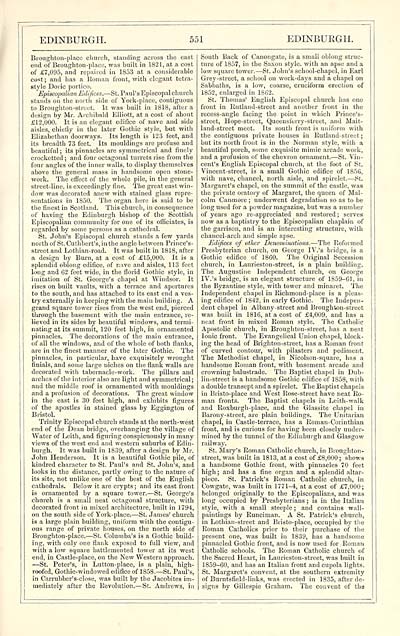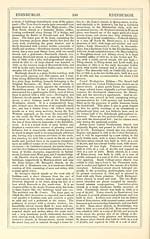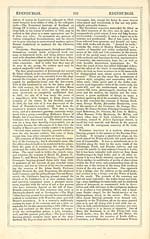Imperial gazeteer of Scotland, or, Dictionary of Scottish topography > Volume 1
(675) Page 551 - EDI
Download files
Complete book:
Individual page:
Thumbnail gallery: Grid view | List view

EDINBURGH.
551
EDINBURGH.
Broughton-place church, standing across tlio east
end of Broughton-place, was built in 1821, at a cost
of .£7,095, and repaired in 1853 at a considerable
cost; and lias a Roman front, with elegant tetra-
style Doric portico.
"Episcopalian Edifices. — St. Paul's Episcopal church
stands on the nortli side of York-place, contiguous
to Broughton-street. It was built in 1818, after a
design by Mr. Archibald Elliott, at a cost of about
£12,000. It is an elegant edifice of nave and side
aisles, chiefly in the later Gothic style, but with
Elizabethan doorways. Its length is 123 feet, and
its breadth 73 feet. " Its mouldings are profuse and
beautiful; its pinnacles are symmetrical and finely
crocketted ; and four octagonal turrets rise from the
four angles of the inner walls, to display themselves
above the general mass in handsome open stone-
work. The effect of the whole pile, in the general
street-line, is exceedingly fine. The great east win-
dow was decorated anew with stained glass repre-
sentations in 1850. The organ hero is said to be
the finest in Scotland. This church, in consequence
of having the Edinburgh bishop of the Scottisli
Episcopalian community for one of its officiates, is
regarded by some persons as a cathedral.
St. John's Episcopal church stands a few yards
north of St. Cuthbert's, in the angle between Prince's-
street and Lothian-road. It was built in 1818, after
a design by Burn, at a cost of £15,000. It is a
splendid oblong edifice, of r.ave and aisles, 113 feet
long and 62 feet wide, in the florid Gothic style, in
imitation of St. George's chapel at Windsor. It
rises on built vaults, with a terrace and apertures
to the south, and has attached to its east end a ves-
try externally in keeping with the main building. A
grand square tower rises from the west end, pierced
through the basement with the main entrance, re-
lieved in its sides by beautiful windows, and termi-
nating at its summit, 120 feet high, in ornamented
pinnacles. The decorations of the main entrance,
of all the windows, and of the whole of both flanks,
are in the finest manner of the later Gothic. The
pinnacles, in particular, have exquisitely wrought
finials, and some large niches on the flank walls are
decorated with tabernacle-work. The pillars and
arches of the interior also are light and symmetrical;
and the middle roof is ornamented with mouldings
and a profusion of decorations. The great window
in the east is 30 feet high, and exhibits figures
of the apostles in stained glass by Eggington of
Bristol.
Trinity Episcopal church stands at the north-west
end of the Dean bridge, overhanging the village of
Water of Leith, and figuring conspicuously in many
views of the west end and western suburbs of Edin-
burgh. It was built in 1839, after a design by Mr.
John Henderson. It is a beautiful Gothic pile, of
kindred character to St. Paul's and St. John's, and
looks in the distance, partly owing to the nature of
its site, not unlike one of the best of the English
cathedrals. Below it are crypts; and its east front
is ornamented by a square tower. — St. George's
church is a small neat octagonal structure, with
decorated front in mixed architecture, built in 1794,
on the south side of York-place. — St. James' church
is a large plain building, uniform with the contigu-
ous range of private houses, on the north side of
Broughton-place. — St. Columba's is a Gothic build-
ing, with only one flank exposed to full view, and
with a low square battlemented tower at its west
end, in Castle-place, on the New Western approach.
— St. Peter's, in Lutton-plaee, is a plain, high-
roofed, Gothic-windowed edifice of 1858. — St. Paul's,
in Carrubber's-elose, was built by the Jacobites im-
mediately after the Revolution. — St. Andrews, in
South Back of Canongate, is a small oblong struc-
ture of 1857, in the Saxon style, with an apse and a
low square tower. — St. John's school-chapel, in Earl
Grey-street, a school on work-days and a chapel on
Sabbaths, is a low, coarse, cruciform erection of
1852, enlarged in 1862.
St. Thomas' English Episcopal church has one
front in Rutland-street and another front in the
recess-angle facing the point in which Prince's-
strect, Hope-street, Queensforry-street, and Mait-
land-street meet. Its south front is uniform with
the contiguous private houses in Rutland-street;
but its north front is in the Norman style, with a
beautiful porch, some exquisite mimic arcade work,
and a profusion of the chevron ornament. — St. Vin-
cent's English Episcopal chinch, at the foot of St.
Vincent-street, is a small Gothic edifice of 1850,
with nave, chancel, north aisle, and spirelet. — St.
Margaret's chapel, on the summit of the castle, was
the private oratory of Margaret, the queen of Mal-
colm Canmore ; underwent degradation so as to be
long used for a powder magazine, but was a number
of years ago re-appreciated and restored ; serves
now as a baptistry to the Episcopalian chaplain of
the garrison, and is an interesting structure, with
chancel-arch and simple apse.
Edifices of other Denominations. — The Reformed
Presbyterian church, on George IV. 's bridge, is a
Gothic edifice of 1860. The Original Secession
church, in Laurieston-street, is a plain building.
The Augustine Independent church, on George
IV.'s bridge, is an elegant structure of 1859-61, in
the Byzantine style, with tower and minaret. The
Independent chapel in Richmond-place is a pleas-
ing edifice of 1842, in early Gothic. The Indepen-
dent chapel in Albany-street and Broughton-street
was built in 1816, at a cost of £4,009, and has a
neat front in mixed Roman style. The Catholic
Apostolic church, in Broughton-street, has a neat
Ionic front. The Evangelical Union chapel, block-
ing the head of Brighton-street, has a Roman front
of curved contour, with pilasters and pediment.
The Methodist chapel, in Nicolson-square, has a
handsome Roman front, with basement arcade and
crowning balustrade. The Baptist chapel in Dub-
lin-street is a handsome Gothic edifice of 1858, with
a double transept and a spirelet. The Baptist chapels
in Bristo-place and West Rose-street have neat Ro-
man fronts. The Baptist chapels in Leith-walk
and Roxburgh-place, and the Glassite chapel in
Barony-street, are plain buildings. The Unitarian
chapel, in Castle-terrace, has a Roman-Corinthian
front, and is curious for having been closely under-
mined by the tunnel of the Edinburgh and Glasgow
railway.
St. Mary's Roman Catholic church, in Broughton-
street, was built in 1813, at a cost of £8,000; shows
a handsome Gothic front, with pinnacles 70 feet
high ; and has a fine organ and a splendid altar-
piece. St. Patrick's Roman Catholic church, in
Cowgate, was built in 1771-4, at a cost of £7,000;
belonged originally to the Episcopalians, and was
long occupied by Presbyterians ; is in the Italian
style, with a small steeple ; and contains wall-
paintings by Runciman. A St. Patrick's church,
in Lothian-street and Bristo-place, occupied by the
Roman Catholics prior to their purchase of the
present one, was built in 1839, has a handsome
pinnacled Gothic front, and is now used for Roman
Catholic schools. The Roman Catholic church of
the Sacred Heart, in Laurieston-street, was built in
1859-60, and has an Italian front and cupola lights.
St. Margaret's convent, at the southern extremity
of Burntsfield-links, was erected in 1835, after de-
signs by Gillespie Graham. The convent of the
551
EDINBURGH.
Broughton-place church, standing across tlio east
end of Broughton-place, was built in 1821, at a cost
of .£7,095, and repaired in 1853 at a considerable
cost; and lias a Roman front, with elegant tetra-
style Doric portico.
"Episcopalian Edifices. — St. Paul's Episcopal church
stands on the nortli side of York-place, contiguous
to Broughton-street. It was built in 1818, after a
design by Mr. Archibald Elliott, at a cost of about
£12,000. It is an elegant edifice of nave and side
aisles, chiefly in the later Gothic style, but with
Elizabethan doorways. Its length is 123 feet, and
its breadth 73 feet. " Its mouldings are profuse and
beautiful; its pinnacles are symmetrical and finely
crocketted ; and four octagonal turrets rise from the
four angles of the inner walls, to display themselves
above the general mass in handsome open stone-
work. The effect of the whole pile, in the general
street-line, is exceedingly fine. The great east win-
dow was decorated anew with stained glass repre-
sentations in 1850. The organ hero is said to be
the finest in Scotland. This church, in consequence
of having the Edinburgh bishop of the Scottisli
Episcopalian community for one of its officiates, is
regarded by some persons as a cathedral.
St. John's Episcopal church stands a few yards
north of St. Cuthbert's, in the angle between Prince's-
street and Lothian-road. It was built in 1818, after
a design by Burn, at a cost of £15,000. It is a
splendid oblong edifice, of r.ave and aisles, 113 feet
long and 62 feet wide, in the florid Gothic style, in
imitation of St. George's chapel at Windsor. It
rises on built vaults, with a terrace and apertures
to the south, and has attached to its east end a ves-
try externally in keeping with the main building. A
grand square tower rises from the west end, pierced
through the basement with the main entrance, re-
lieved in its sides by beautiful windows, and termi-
nating at its summit, 120 feet high, in ornamented
pinnacles. The decorations of the main entrance,
of all the windows, and of the whole of both flanks,
are in the finest manner of the later Gothic. The
pinnacles, in particular, have exquisitely wrought
finials, and some large niches on the flank walls are
decorated with tabernacle-work. The pillars and
arches of the interior also are light and symmetrical;
and the middle roof is ornamented with mouldings
and a profusion of decorations. The great window
in the east is 30 feet high, and exhibits figures
of the apostles in stained glass by Eggington of
Bristol.
Trinity Episcopal church stands at the north-west
end of the Dean bridge, overhanging the village of
Water of Leith, and figuring conspicuously in many
views of the west end and western suburbs of Edin-
burgh. It was built in 1839, after a design by Mr.
John Henderson. It is a beautiful Gothic pile, of
kindred character to St. Paul's and St. John's, and
looks in the distance, partly owing to the nature of
its site, not unlike one of the best of the English
cathedrals. Below it are crypts; and its east front
is ornamented by a square tower. — St. George's
church is a small neat octagonal structure, with
decorated front in mixed architecture, built in 1794,
on the south side of York-place. — St. James' church
is a large plain building, uniform with the contigu-
ous range of private houses, on the north side of
Broughton-place. — St. Columba's is a Gothic build-
ing, with only one flank exposed to full view, and
with a low square battlemented tower at its west
end, in Castle-place, on the New Western approach.
— St. Peter's, in Lutton-plaee, is a plain, high-
roofed, Gothic-windowed edifice of 1858. — St. Paul's,
in Carrubber's-elose, was built by the Jacobites im-
mediately after the Revolution. — St. Andrews, in
South Back of Canongate, is a small oblong struc-
ture of 1857, in the Saxon style, with an apse and a
low square tower. — St. John's school-chapel, in Earl
Grey-street, a school on work-days and a chapel on
Sabbaths, is a low, coarse, cruciform erection of
1852, enlarged in 1862.
St. Thomas' English Episcopal church has one
front in Rutland-street and another front in the
recess-angle facing the point in which Prince's-
strect, Hope-street, Queensforry-street, and Mait-
land-street meet. Its south front is uniform with
the contiguous private houses in Rutland-street;
but its north front is in the Norman style, with a
beautiful porch, some exquisite mimic arcade work,
and a profusion of the chevron ornament. — St. Vin-
cent's English Episcopal chinch, at the foot of St.
Vincent-street, is a small Gothic edifice of 1850,
with nave, chancel, north aisle, and spirelet. — St.
Margaret's chapel, on the summit of the castle, was
the private oratory of Margaret, the queen of Mal-
colm Canmore ; underwent degradation so as to be
long used for a powder magazine, but was a number
of years ago re-appreciated and restored ; serves
now as a baptistry to the Episcopalian chaplain of
the garrison, and is an interesting structure, with
chancel-arch and simple apse.
Edifices of other Denominations. — The Reformed
Presbyterian church, on George IV. 's bridge, is a
Gothic edifice of 1860. The Original Secession
church, in Laurieston-street, is a plain building.
The Augustine Independent church, on George
IV.'s bridge, is an elegant structure of 1859-61, in
the Byzantine style, with tower and minaret. The
Independent chapel in Richmond-place is a pleas-
ing edifice of 1842, in early Gothic. The Indepen-
dent chapel in Albany-street and Broughton-street
was built in 1816, at a cost of £4,009, and has a
neat front in mixed Roman style. The Catholic
Apostolic church, in Broughton-street, has a neat
Ionic front. The Evangelical Union chapel, block-
ing the head of Brighton-street, has a Roman front
of curved contour, with pilasters and pediment.
The Methodist chapel, in Nicolson-square, has a
handsome Roman front, with basement arcade and
crowning balustrade. The Baptist chapel in Dub-
lin-street is a handsome Gothic edifice of 1858, with
a double transept and a spirelet. The Baptist chapels
in Bristo-place and West Rose-street have neat Ro-
man fronts. The Baptist chapels in Leith-walk
and Roxburgh-place, and the Glassite chapel in
Barony-street, are plain buildings. The Unitarian
chapel, in Castle-terrace, has a Roman-Corinthian
front, and is curious for having been closely under-
mined by the tunnel of the Edinburgh and Glasgow
railway.
St. Mary's Roman Catholic church, in Broughton-
street, was built in 1813, at a cost of £8,000; shows
a handsome Gothic front, with pinnacles 70 feet
high ; and has a fine organ and a splendid altar-
piece. St. Patrick's Roman Catholic church, in
Cowgate, was built in 1771-4, at a cost of £7,000;
belonged originally to the Episcopalians, and was
long occupied by Presbyterians ; is in the Italian
style, with a small steeple ; and contains wall-
paintings by Runciman. A St. Patrick's church,
in Lothian-street and Bristo-place, occupied by the
Roman Catholics prior to their purchase of the
present one, was built in 1839, has a handsome
pinnacled Gothic front, and is now used for Roman
Catholic schools. The Roman Catholic church of
the Sacred Heart, in Laurieston-street, was built in
1859-60, and has an Italian front and cupola lights.
St. Margaret's convent, at the southern extremity
of Burntsfield-links, was erected in 1835, after de-
signs by Gillespie Graham. The convent of the
Set display mode to: Large image | Transcription
Images and transcriptions on this page, including medium image downloads, may be used under the Creative Commons Attribution 4.0 International Licence unless otherwise stated. ![]()
| Gazetteers of Scotland, 1803-1901 > Imperial gazeteer of Scotland, or, Dictionary of Scottish topography > Volume 1 > (675) Page 551 - EDI |
|---|
| Permanent URL | https://digital.nls.uk/97467230 |
|---|
| Description | Volume I: Aan-Gordon. |
|---|---|
| Attribution and copyright: |
|

